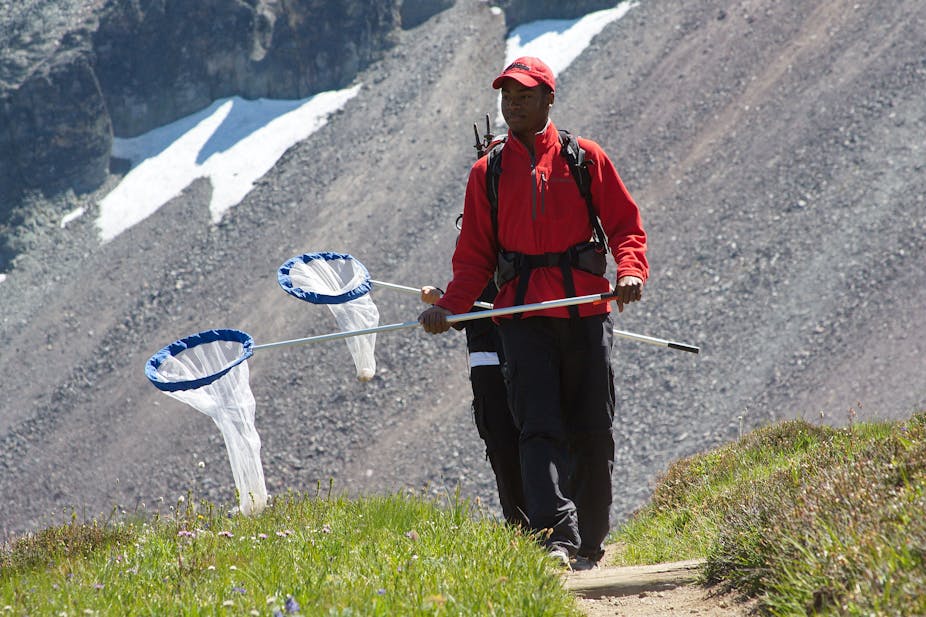December 1900 marked the first ever “Christmas Bird Count”. Its aim was to get people counting bird species rather than killing them. It’s now an annual tradition. Every year on a specific day between December 14 and January 5, thousands of volunteers – ordinary people, not scientists – gather in more than 2,000 locations in the Western hemisphere to count birds.
Conservation biologists use this data to assess bird populations’ health and look at long-term trends.
This is probably the earliest recorded example of citizen science, a phenomenon that filmmaker Geoff Haines-Stiles calls
…science with, for and by the people.
Haines-Stiles, who produced the scientific TV series “Cosmos” during the 1980s, is an enthusiastic fan of citizen science. “It is truly a revolution in the way science is done,” he said during an online seminar organised by the Berlin Museum for Natural Science on July 18 2016. “It allows people who are not traditionally involved in doing science and gathering data, to become active contributors to real science.”
This is as true in Africa as it is elsewhere in the world. More and more Africans are becoming citizen scientists – and the benefits are huge both for them as individuals and for science on the continent.
African initiatives
Gathering environmental data is a key focus of African citizen science.
In South Africa, Kenya and Uganda, for instance, volunteers monitor and record data on everything from mangrove ecosystems to beach erosion; along with a variety of animals and insects like sea turtles, bats, owls, frogs, lizards and butterflies.
Cape Citizen Science asks nature lovers to become “pathogen hunters” while on nature walks. This is done by recording dying fynbos plants and collecting samples of the dead plant material. From time to time, visitors to South Africa’s Kruger National Park are asked to help monitor endangered species like wild dogs and cheetahs by submitting their photographs of these animals.
With internet access, it’s even possible to contribute to African-based citizen science projects around the globe without leaving home. Wildebeest Watch invites people to explore collective intelligence in these animals as they navigate the Serengeti. Snapshot Serengeti asks for help in sorting photos gathered by hundreds of camera traps in Tanzania’s Serengeti National Park.
Professor Les Underhill of the University of Cape Town’s Animal Demography Unit (ADU) is a pioneer of citizen science on the continent. Over the past 25 years, his research group has integrated citizen data into ambitious research projects across southern Africa. Through this unit, data from citizen scientists are feeding into atlases and distribution maps of birds, dung beetles, frogs, scorpions, spiders, butterflies, dragonflies, lacewing moths, sea stars, mushrooms and orchids.
The unit’s innovative virtual museum contains more than 6,000 photographic records provided by hundreds of citizen scientists. Most of their bird ringers are amateurs, not professional scientists, who spend their own time and money to contribute valuable ringing data.
“Each data point the ADU’s citizen scientists collect is a piece in the jigsaw puzzle of biodiversity,” Underhill says. “It is our job to turn the myriad bits of raw data into information that can support conservation policy and action.”
The limitations of citizen science
The contribution of citizen science goes beyond gathering or unravelling data. Enthusiastic volunteers also bring their computer equipment and technological skills to assist with number crunching and data analysis. They can fill in knowledge gaps by providing scientists with extra hands, eyes, computers, cameras, smartphones and vehicles.
But not everybody is convinced.
“Citizen science” is an oxymoron.“ That’s what Dr Rob Little, a biologist at the Percy Fitzpatrick Institute of African Ornithology at the University of Cape Town, told me recently. "It is not possible to be a citizen dentist or a citizen lawyer, so why citizen scientists?” he asks. “Being a scientist requires a minimum of MSc-level training.”
Other criticisms revolve around the quality of data collected by non-experts and the potential for conflicts of interest – ordinary people who are opposed to fracking, for instance, might get involved in projects just to gather information that supports their stance.
Inclusivity is also a particular challenge when it comes to citizen science projects. It can be difficult to involve people who don’t have their own transport or access to smartphones, computers and internet; or where literacy rates are low. Some initiatives in Africa are getting creative to address these problems. The Extreme Citizen Science research group in the Democratic Republic of Congo is doing some great work with communities in this regard.
A powerful force for change
Despite its limitations, citizen science has an important place in Africa. It is a way of driving public engagement; of creating linkages and dialogue between science and society. It can inspire people to take an interest in science and enthuse young people about careers in science. It helps make science a part of everyday life – after all, the evidence of science’s benefits is all around us.
It is also a vital step towards democratising science.

